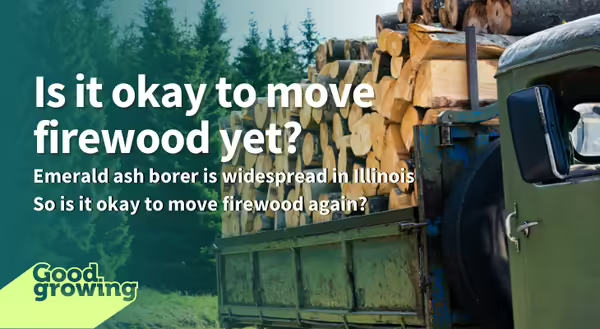
Many years ago, when emerald ash borer (EAB), had just arrived in northern Illinois, a colleague came across a flatbed trailer loaded with cut ash trees at a gas station. At that time Illinois counties confirmed with EAB had a quarantine that restricted moving ash wood outside of the county.
Most Extension folks (me included) have a tough time claiming we are an expert on a particular topic, but I must admit, this Extension person at the gas station was an expert. They knew the rules on moving ash wood at the time. It seemed only fitting for this Extension educator to let the truck driver know what they were doing was prohibited.
The response of the person hauling the ash trees was, “You can’t tell me what to do.” In reality, there were more choice words in that statement, so go ahead and use your imagination to fill in the blanks. It will be like a game of Mad Libs. But the truck driver was right, Illinois Extension is not here to tell you what to do. Our job at Illinois Extension is to use the most current research and unbiased information we have to help you make informed decisions.
What happens when the choices we make affect people we will never meet? Now that EAB is throughout Illinois, the county quarantines are no longer in force. But what was the cost? According to estimates published in Arboriculture & Urban Forestry, it is estimated the costs of EAB to community parks, private land, and along streets in Illinois, Indiana, Michigan, and Wisconsin are between $13.4 and $26 billion. That’s a fair chunk of change that most homeowners and municipalities don’t have in their budget.
I can certainly attest to the cost of EAB. We have several ash trees in our yard. This year alone we spent over $2,000 to have trees treated and removed as we slowly transition our canopy away from ash. We can neither afford to treat them all nor to have them all removed and replaced. It is a strategy many people and organizations have adopted to help cushion the financial blow.
Are we to blame the truck driver for hauling dead ash trees across the state over a decade ago? It is not practical to blame one person. Truly, EAB would have made it to our yards eventually. Wait, if EAB was going to get here anyway, why all the firewood fuss?
We can’t dismiss the responsibility to slow the spread of an invasive species. Because there’s more than EAB, and like EAB these invasive pests will get here eventually causing harm to our urban, rural, and natural areas. Our globalized economy has put our ecosystems in the blender and right now we’re trying to hold the lid on to keep everything from becoming a huge expensive mess. And hopefully, save as many species from extinction as possible.
Bottom Line on Moving Firewood
Since the Illinois county quarantine has been dropped is it now okay to move firewood? Hardwood firewood is not regulated in Illinois and can move freely across the state. Even still, Illinois Extension does not recommend moving firewood. Burn it where you buy it. Will it cost a couple of extra bucks? Of course, but I’d rather pay $10 than $2,000.
Learn more about Illinois invasive species.
Good Growing Tip of the Week: While the internal county quarantine has been lifted, currently, there is still a federal USDA quarantine of several Midwestern states on ash wood products. For up-to-date information on where ash quarantine boundaries are located, please contact Illinois Department of Agriculture or your local USDA office.
Signup for our emails!
Want to get notified when new Good Growing posts are available? SIGN ME UP
MEET THE AUTHOR
Chris Enroth is a horticulture educator with University of Illinois Extension, serving Henderson, McDonough, Knox, and Warren counties since 2012. Chris provides horticulture programming with an emphasis on the home gardener, landscape maintenance personnel, and commercial landscapers. Additional responsibilities include coordinating local county Master Gardener and Master Naturalist volunteers - providing their training, continuing education, advanced training, seasonal events, and organizing community outreach programs for horticulture and conservation assistance/education. In his spare time, Chris enjoys the outdoors, lounging in the garden among the flowers (weeds to most).